SOILS THE HIDDEN FACTOR IN THE RISE AND FALL OF CIVILIZATIONS
COLONIAL SYDNEY, A CASE STUDY
Some Historians write about Kings and Queens or Admirals and Generals or priests and heathens. This history is about soils, the foundation of all civilizations. Birth of early civilizations Where was the birth of ancient civilizations? In the great river valleys where ample fertile alluvial soils coexisted with a good supply of fresh water. The Nile in Egypt, Tigris and Euphrates in Mesopotamia and Babylon, Indus valley and China . Agriculture on fertile soils enabled the human race to build great nations. . Early man was often nomadic, it was necessary to move from place to place to find food. Where there was fertile soils ancient man could obtain all his food from the one spot. In these areas where people settled on fertile soils he domesticated animals and cultivated plants. When early agriculture began, only a small number of people were required to produce food. Civilizations began when a large workforce was free from food production and able to build up large and powerful nations. Imagine a world without fertile soils, would humans still exist as nomadic tribes travelling over the land looking for food to eat? SYDNEY SHAPED BY SOILS The First Fleet arrived in Sydney with about 1500 new settlers, convicts, officials, sailors and Marine guards in Feb 1788. A Government farm was quickly established where Sydney Botanical Gardens now exist. A crop of wheat, barley and maize was sown. In Nov. less grain was harvested than originally sown. The crop was an absolute failure. Infertile soils formed on Hawkesbury Sandstone was the main factor contributing to crop failure. Trees blunted the axes, soil blunted the spades and picks, the men were not inclined to work hard. English wheat and barley rotted in the ground and the weevil destroyed the seed. The Colony was starving in the beginning of 1791 and a major disaster was averted when a supply ship from England arrived in July 1791. Many expeditions were made to search for good soils. Growing food was a very important aim in new colony. A settlement was established at Rose Hill in Nov. 1788 (Parramatta) and farms were established on the creek flats and surrounding Wianamatta Shales. More farms were established west of Parramatta, on the slopes of the volcanic Prospect Hill. Government Experiment Farms were established at Toongabbie and other sites. A very successful early farmer was Rev. Richard Johnson who was given a grant of land near Canterbury on Wianamatta Shales and river flats of Cooks River. Johnson grew successful wheat crops before Ruse. Land grant to Ruse 21 st Nov 1789, 30 acres. “burned the fallen timber, dug in the ashes, clod-molded it, dug in grass and weeds, exposed the soil to air and sun, and dug it in again. Feb. 1791 Ruse able to feed himself and family. Captain Johnston received grant 1793, Annandale on Wianamatta Shale. John Macarthur received grant 100 acres Parramatta, 1793. and 5 000 acres Cowpastures, Camden 1805. Farms established on the rich alluvial flats of the Hawkesbury River became a major food supplier to Sydney. The road to Bathurst over the Blue Mountains encouraged rapid expansion of agriculture in Western New South Wales. The early settlers in Sydney quickly learnt how infertile Hawkesbury Sandstone soils are. Many houses in early Sydney possessed extensive gardens. Government House, Hospital and Lieutenant Governor were able to grow a variety of vegetables and fruits. Melons, grapes and citrus were able to grow on infertile soils. Tench predicted in 1791 wine would become a successful product of the Colony in the future. Parramatta is now the second largest center in Sydney. At first water transport was used to Parramatta and then a bush track. Usable road 18 feet wide constructed 1794. Little settlements were established along the bush track to Parramatta with numerous pubs providing refreshments to travelers and horses. Burwood is approximately half way between Sydney and Parramatta and was half way overnight stay for convicts and a staging post with inn. Bullock team could travel about 10 miles a day. Some successful little farms were established in this area. The Macquarie Towns along the Hawkesbury River were established to provide housing for farmers above flood levels. In June 1788, 4 cows and 2 bulls escaped and in a journey of exploration discovered tasty pastures on the rich alluvial soils at Cowpastures near Camden on the Nepean River. This little heard successfully multiplied to 60 head of cattle when rediscovered in 1795. Population 26th Nov. 1791 Sydney 1259 Parramatta 1628 Norfolk Island 1172 Total Colony 4059 There were more new settlers in Parramatta than Sydney. In these early years more effort was placed on growing food than building a nation. Before the 2nd fleet, only few sheep remained of about 70 purchased at the Cape. A violent thunderstorm occurred within two weeks of coming on shore and lightening killed a few sheep. Hogs and poultry did well. All cattle escaped in June 1788. Macarthur imported 4 merino ewes and 2 rams from Cape of Good Hope 1796. Macarthurs aim was to breed sheep to produce fine wool. Tench comment on grass. Grass grows everywhere except in swamps. The grass does not overspread the land in a continued sward, but arise in small detached tufts, growing every way about three inches apart, the intermediate space being bare, though the heads of the grass are often so luxuriant, as to hide all deficiency on the surface. Grass is not of finest quality and agrees better with horses and cows than sheep. This description would be native permanent grass different to English grass. Large spreading trees of little use as timber had bad grain. Little understorey. Tench comment on soils. Many spots cursed with everlasting and unconquerable sterility. He believed many large tracts of land, between Rose Hill and Hawkesbury River are of a nature sufficiently favorable to produce moderate crops. Cattle will need to be imported in a sufficient number to afford manure for dressing the ground. Experiments in mixing different soils failed. Tench comment on survey. Our method on these expeditions, was to steer by compass, noting the different courses as we proceeded; and counting the number of paces, of which two thousand two hundred, on good ground, were allowed to be a mile. At night when we halted, all these courses were separately cast up, and worked by a traverse table, in the manner a ships reckoning is kept; so by that by observing this precaution, we always knew exactly where we were, and how far from home: an unspeakable advantage in a new country, where one hill,and one tree, is so like another, that fatal wanderings would ensure without it. Mr. Dawes, who, from habit and superior skill, performed it almost without a stop, or an interruption of conversation: to any other man, on such terms it would have been impracticable. Good brick making clay was soon discovered at Brickfield Hill near Goulburn Street. No readily available limestone was close to Sydney and sea shells were used to make mortar. Surrounding the harbour foreshore many aboriginal middens exist. The first windmill was built in 1796 at Millers point. Early Maps Capt. Hunter and Lieut. Bradley, March 1788, with gardens at hospital, Governor House, Lt Governor House. Captain Watkin Tench of the Marines, 1791 “A Map of the hitherto explored COUNTRY, Contiguous to PORT JACKSON: Laid from Actual Survey.” Lieutenant Dawes of the Royal Engineers March 1791 “A MAP of all these Parts of the Territory of NEW SOUTH WALES which have been seen by any- Persen ‘belonging to the’ settlement established at PORT JACKSON, in faid Territory. A map of the Colony adopted from a survey plan first published in London in May 1798. “Fairfield, a history of the district.” Charles Alexandre Lesueur 1802 French artist-naturalist on Captain Baudin expedition. (spy?)
- Captain Watkin Tench
-
- Captain Watkin Tench of the Marines, 1791 “A Map of the hitherto explored COUNTRY, Contiguous to PORT JACKSON: Laid from Actual Survey.”
- This map was in
- CAPTAIN WATKIN TENCH of the marines. SYDNEY FIRST FOUR YEARS being a reprint of A NARRATIVE OF THE EXPEDITION TO BOTANY BAY and A COMPLETE ACCOUNT OF THE SETTLEMENT AT PORT JACKSON, Library of Australian History Sydney 1979.
- Tench was a Marine who sailed in the First Fleet, arriving in Colonial Sydney 1788 and departed for England in Dec. 1791. Two books were published and the combined books published after Tench return to England in 1793. The major contents of his books were from his Journal. Tench made several expeditions inland to Nepean River and accurate surveys were made on these expeditions and recorded on his map.
- My discovery of Tench book and map stimulated me to begin a study of Soils and History.
- Lieutenant Dawes of the Royal Engineers March 1791 “A MAP of all these Parts of the Territory of NEW SOUTH WALES which have been seen by any- Persen ‘belonging to the’ settlement established at PORT JACKSON, in faid Territory.
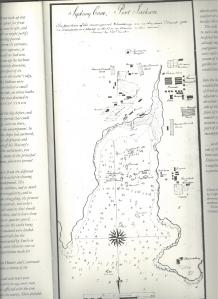
- Capt. Hunter and Lieut. Bradley, March 1788, with gardens at hospital, Governor House, Lt Governor House.
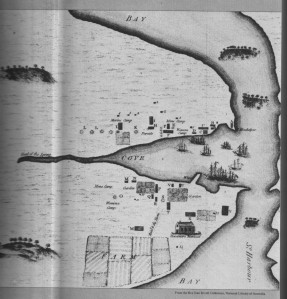
- Charles Alexandre Lesueur 1802 French artist-naturalist on Captain Baudin expedition. (spy?)
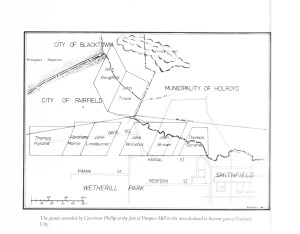 Prospect Hill
Prospect Hill 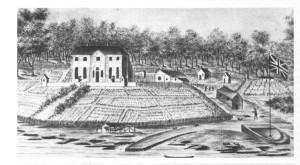 1st Government House. Showing extensive gardens.
1st Government House. Showing extensive gardens. 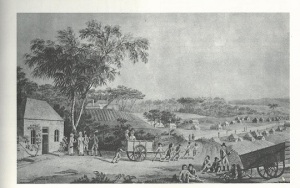 Parramatta. In the early colony there were few horses and many convicts.
Parramatta. In the early colony there were few horses and many convicts. 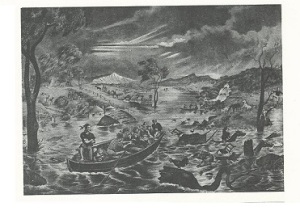 Floods on Hawkesbury River in early 1800s.
Floods on Hawkesbury River in early 1800s. 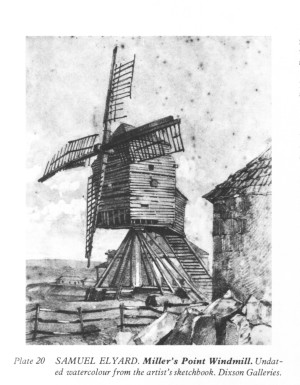 1st windmill, built 1796 in Millers point. Windmills were built on ridges surrounding early Sydney to produce flour from wheat and maize. After 1850 steam replaced windmills.
1st windmill, built 1796 in Millers point. Windmills were built on ridges surrounding early Sydney to produce flour from wheat and maize. After 1850 steam replaced windmills.  Cowpastures discovered 1795. John Macarthur grant 5,000 acres 1805. Healthy soils are the foundation of civilizations. Is the destruction of soils the downfall of civilizations? Peak Soil, do we have a problem? Ted Floyd tedfloyd.wordpress.com http://www.ramin.com.au/creekcare ted7floyd@gmail.com
Cowpastures discovered 1795. John Macarthur grant 5,000 acres 1805. Healthy soils are the foundation of civilizations. Is the destruction of soils the downfall of civilizations? Peak Soil, do we have a problem? Ted Floyd tedfloyd.wordpress.com http://www.ramin.com.au/creekcare ted7floyd@gmail.com
Sydney Soil History
Tench map west
tench map north
tench map inner sydney
Sydney Soils
Tench map west
tench map north
tench map inner sydney
Sydney Soils
The 1st fleet arrived in Sydney in 1788. The early history of Sydney was dominated by soils. Government Farm failed miserably. The soil was an infertile, sandy soil and the 1st settlers were heartbroken as they tried to grow wheat, maize and barley with yields less than the seed sown. Their little herd of cattle escaped and found better pastures 20 miles down south. By early 1791 the colony was starving and it was feared most settlers would die of hunger.
In June 1791 the 2nd fleet arrived with stores and hundreds of sick convicts who were cruelly treated on the convict ships. Sydney was saved and many times since Australia has suffered from droughts, floods crop failures, mice plagues, grasshopper plagues, salty soils, water erosion, dust storms, acid soils and many silly politicians. Despite all this farmers have fed the locals and exported food to a hungry world. In past years it was said Australia grew from the wool on a sheeps back. Our economy is now dominated by coal and gold. In the future will global warming dominate the economy and natural biocarbon sinks replace the dominance now held by coal? The greatest asset Australia posses for generating biocarbon sinks is soil.
Sydney founded 26 Feb 1788
map sydney 1788
Early map of Sydney showing 1st Government farm, behind Gov. House on land now part of Botanic Gardens.
gov house 1
Ist Gov. House with extensive gardens in front of house. Many houses maintained vegetable gardens to provide fresh vegetables, especially when rations were reduced because of reduction in Government supplies.
Government Farm established near Farm Cove (present Sydney Botanic Gardens).
Soils were shallow, infertile, sandy soils formed on Hawkesbury Sandstone rocks.
The Officers and soldiers were smart enough on parade, but were useless on a farm. The profession of the convicts was to do no work and to gain an income by dubious means. No new settler was a farmer.
The ground bent the blades of hoes. Timber twisted the the blades of axes. Summer heat was oppressive and giant ants bit everyone. The seasons were confusing and trees never lost their leaves. In many months it never rained and then a violent storm dropped flooding rains. The production of wheat and barley was not sufficient to feed a hungry new settlement. Supplies originally brought out with 1st Fleet began to run out.
2 bulls and 4 cows lost June 1788 (60 head of cattle found Cowpastures Camden 1795)
1st crop failed Sept 1788.
1st Government farm abandoned.
Several food plants grew well in early Sydney. Maize best grain crop. Vines flourished and grapes produced good wines. Melons, cucumbers and pumpkins grew well. Oranges lemons and figs best fruit trees. Most settlers with allotments possessed pigs and poultry. In early Sydney sheep, cattle and horses were rare and only wealthy land owners possessed these stock. Horses and bullocks were not available to pull wagons. There was plenty of convicts who pulled the carts and wagons.
tench map
Captain Watkin Tench published his diaries 1792 “SYDNEY’S FIRST FOUR YEARS”. He was interested in agriculture and soils and his diaries contained good descriptions of farming. Included in his diaries was the very interesting map.
Paramatta settled Nov 1788.
Farming was more successful on the alluvial creek flats and the surrounding Wianamatta shales.
Prospect Hill, west of Paramatta, is basaltic with fertile soils on the surrounding slopes.
James Ruse land grant on 21st Nov. 1788, Rose Hill (Paramatta).
Ruse was very successful and the 1st farmer who grew enough food to feed his family.
Norfolk Island had good soils and settlers sent to the island to reduce the number of starving mouths in Sydney.
Starvation became a reality in the colony.
2nd fleet arrived with stores and averted starvation June 1791.
map prospect 1792
Ponds a settlement North Paramatta, 14 allotments Dec 1791.
Prospect Hill settled 1791, 11 allotments Dec 1791.
Prospect Hill, west of Paramatta is basaltic with fertile soils on surrounding slopes.
Population 26th Nov. 1791
Sydney 1259
Paramatta 1628
Norfolk Island 1172
Total Colony 4059
There were more new settlers in Paramatta than Sydney. In these early years more effort was placed on growing food than building a nation.
13th Dec 1791 Marines left Sydney on Gorgon
Captain Phillip left for England.
Toongabbe Government farm
Hawksbury River. 1st land grants 1794. Macquarie Towns 1810, Windsor, Richmond, Pitt Town, Wilberforce, and Castlereagh. The towns were built on higher ground above floods. This enabled farmers to live above floods and to farm the flood prone river flats. Farm produce by boat down Hawksbury, Broken Bay, and along coast to Sydney Harbour.
Captain Johnston received grant 1793, Annandale on Wianamatta Shale.
John Macarthur received grant 100 acres Paramatta, 1793. and 5 000 acres Cowpastures, Camden 1805.
map sydney 1798
Map 1798, Sydney and surrounding settlements.
windmill 1
1st windmill, Millers point. Windmills were built on ridges surrounding early Sydney to produce flour from wheat and maize. After 1850 steam replaced windmills.
cowpastures
Cowpastures discovered 1795. John Macarthur grant 5,000 acres 1805.
Birth of early civilizations
The birth of civilization occurred where there was fertile soils. Alluvial soils Nile, Tigris, Euphrates, Indus and in China.The great civilizations of Egypt, Babylon, India and China. Early man was often nomadic, it was necessary to move from place to place to find food. Where there was fertile soils ancient man could obtain all his food from the one spot. In these areas where people settled on fertile soils he domesticated animals and cultivated plants. Early agriculture began, only a small number of people were required to produce food. Civilizations began when a large workforce was free from food production and able to build up large and powerful nations. The necessary elements for ancient civilizations was fertile soils and water.
Permalink: http://whoknowsted.wordpress.com/sydney-history-and-soils/
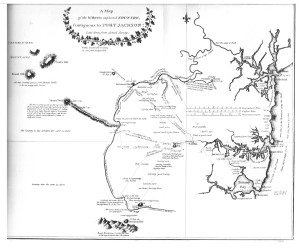
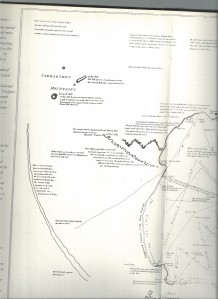
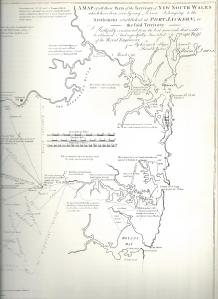
Thanks Jessica M. DeWitt
I am interested in adding to projects on maps of early Sydney.
Ted Floyd
By: Ted Floyd on July 28, 2015
at 2:36 am
Hi Ted,
Just wondering if you could tell me where the image of the flood in the Hawkesbury came from. I’m researching Andrew Thompson and he was credited with saving over 300 people in the floods of 1806 & 1809. Been trying to find an image of him and wondering if it could be him in the boat. I haven’t seen that image before. Thanks.
By: Venecia Wilson on September 9, 2015
at 6:47 am